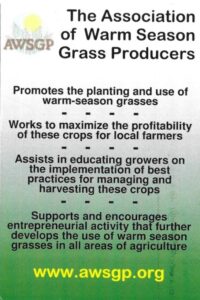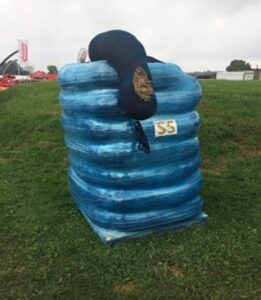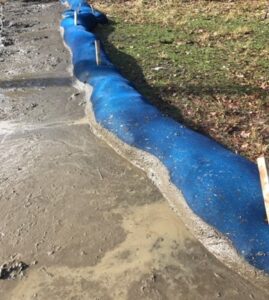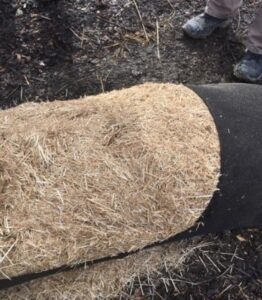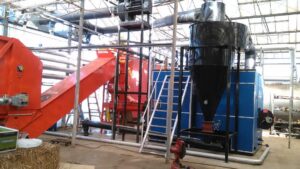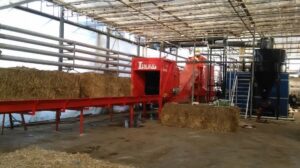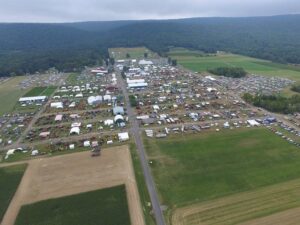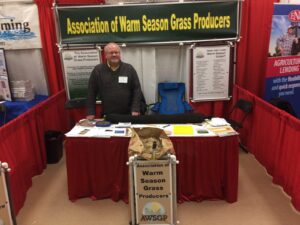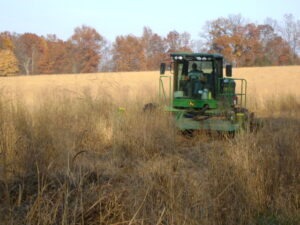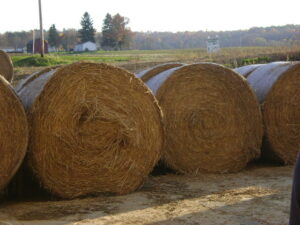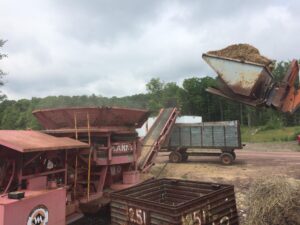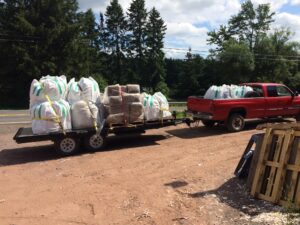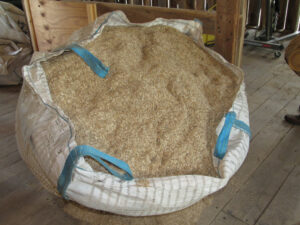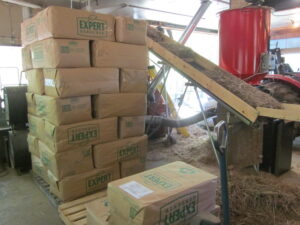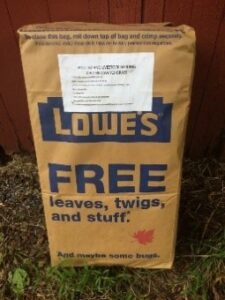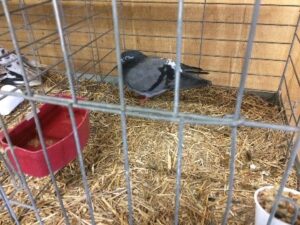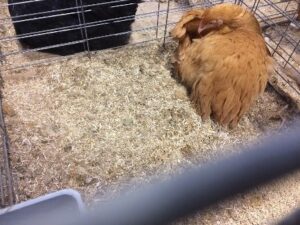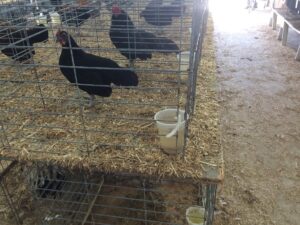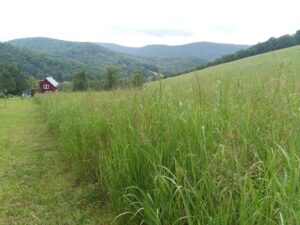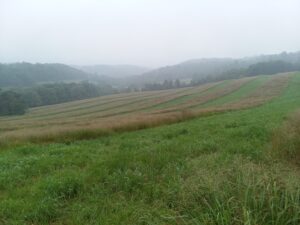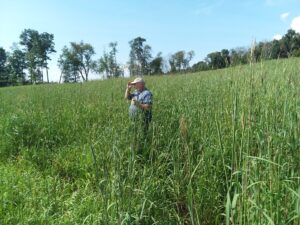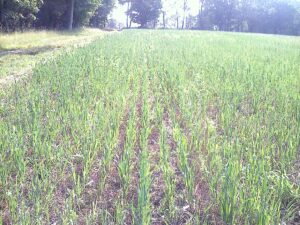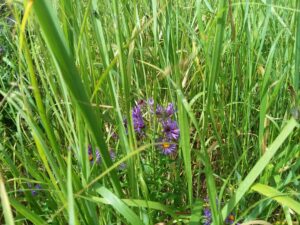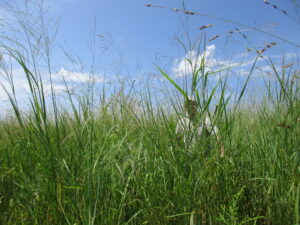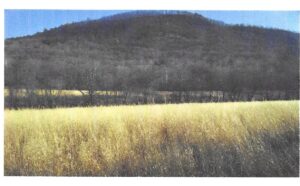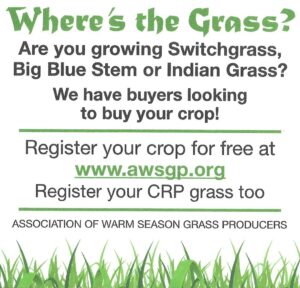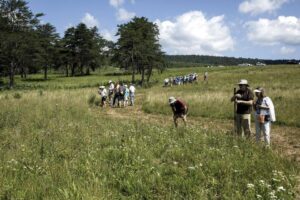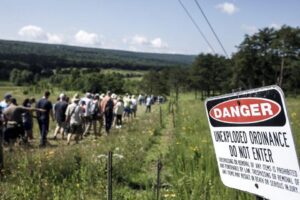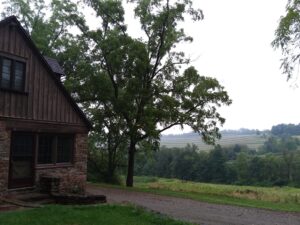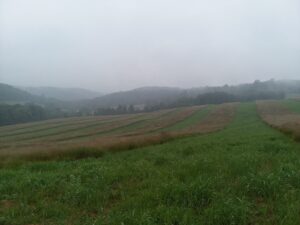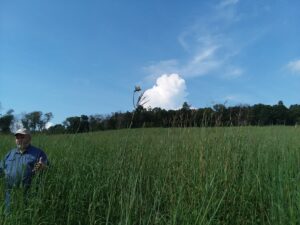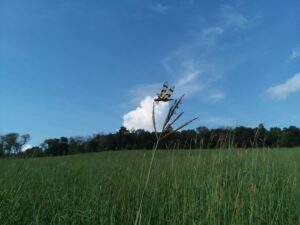Final report for ONE18-320
Project Information
The Association of Warm Season Grass Producers marketed the many economic and environmental benefits of using warm season grasses within the Pennsylvania farm community. In many cases, warm season grasses outperform bedding straw or sawdust which are traditionally used. Many farmers are not familiar with these benefits. When asked for assistance, members of the Association did not know who grew and sold warm season grass products. We needed a directory of growers and suppliers by county in Pennsylvania.
Farm cooperators from the Association participated in 4 Pennsylvania farm shows & ag expos. They interacted with farmers and fair participants, supplied them with educational publications and supporting literature that highlighted the many economic and environmental benefits from using warm season grass in farming operations. They demonstrated its absorbency as livestock and poultry bedding, its capability as a boiler fuel, and its superior absorbency when used in a silt sock as an erosion and sedimentation control measure.
Farm cooperators from the Association of Warm Season Grass Producers also exhibited Switchgrass at 4 county fairs & the PA Farm Show. They replaced traditional bedding materials used in the livestock/poultry barns with warm season grass. They supplied them with 200-pound supersacks of processed, ground-up grass. The livestock handlers provided positive feedback on their experiences using Switchgrass as bedding. Poultry handlers liked that it stayed in the metal-bottomed cages and there was reduced dust. However, they found the large super sacks hard to maneuver and there were some thorns embedded in the grass, requiring the use of gloves.
Fairs and farm shows are invaluable in building relationships with farmers. Some farmers placed orders for grass to use at their own farms; some found markets for grass they currently grow; twenty farmers committed to planting grass on their own farm acreage; and fifty farmers joined the Association of Warm Season Grass Producers during this marketing campaign.
The Association created a directory of grass producers containing the producer’s farm location, acreage in grass production, species and varieties of grass being grown, willingness to sell grass and related products, and delivery radius in miles and by county. Therefore, when a project, farmer, or fair event needs grass products, farmers will know who in a geographic area has material to supply. An interactive map showing locations of farms producing grass by county was produced using Google Maps.
To provide a level of quality control, a physical method was adopted to measure weed content within a field of grass. Farmers and the Association can use this assessment method to help market their grass products.
Overall, the Association interacted and educated approximately 12,000 people including some farmers visiting or exhibiting livestock & poultry at the various fairs, shows, and ag expos. The Association also generated media outreach by placing display ads and press releases in farming newspapers and magazines, educating approximately 22,800 readers as part of the campaign to market the many economic and environmental benefits of using warm season grass in farming operations.
The price of Switchgrass climbed from $65 to $90 to $150-165 per ton during the length of this grant project.
The Association’s website www.awsgp.org visitation log has climbed from a few hundred per month to over 600 visits per month during this project’s duration. Also, during that period, the Association gained 50 new members, of which 20 are new grass producers.
To launch a marketing campaign throughout Pennsylvania’s farming community that educates and promotes the many economic and environmental benefits of using warm season grasses, and to develop a directory of warm season grass producers by county in Pennsylvania. The Association of Warm Season Grass Producers in partnership with the Penn Soil RC&D Council and Penn State Ag Extension will reach out to at least 5,000 Pennsylvania farmers during 2018-19, will help them discover the many environmental and cost-saving benefits of these grasses, will illustrate their superior properties when compared with traditional hay-straw and sawdust products, and will help them begin using these grasses in their farming operations. The Association membership will survey growers and suppliers by county in Pennsylvania and will publish a directory and map of those growers and suppliers to include producer’s location, product type (grass species), product form (round or square bales), availability, and delivery distance.
Pennsylvania farmers, who could benefit by using warm season grasses in their farming operations, simply don’t understand the many benefits of warm season grasses, nor do they know who grows and sells these products. The Association of Warm Season Grass Producers will reach out to at least 5,000 Pennsylvania farmers during 2018, help them discover the many benefits of these grasses, and help them begin using these alternative beneficial crops in their farming operations. The Association membership, however, does not know the location of most Pennsylvania growers and suppliers. For instance, during the 2017 Lancaster County Fair, a farmer producing select, organic eggs decided to use switchgrass for her chickens’ bedding. When asked who in Lancaster County could supply switchgrass for bedding, no Association member could provide the name of a switchgrass grower in that county. Needed is a directory of growers and suppliers by county in Pennsylvania.
Much has been reported about warm season grasses and their many economic and environmental benefits. In many cases, warm season grasses outperform traditionally used material such as bedding straw or sawdust. Specialized reports touting the benefits and virtues of warm season grass are in publications that farmers do not readily access and read. These reported benefits are not getting to the audience that needs the information the most. This proposed marketing campaign is designed to get the benefits of warm season grass use into the farm community by showing them firsthand what this grass looks like and how its many product forms can outperform other products used to sustain farms. We will build on what has been reported in research reports by bringing information and publications to farmers and end users who visit Pennsylvania’s ag-shows, expos, and fairs. These venues are also excellent opportunities to provide farmers a directory of grass growers by Pennsylvania county.
Cooperators
- (Educator)
- (Educator)
- (Educator)
- (Educator and Researcher)
- (Educator)
- (Educator)
- (Educator)
- (Educator)
- (Educator and Researcher)
- (Educator)
- (Educator)
- (Educator)
- (Educator and Researcher)
- (Educator and Researcher)
- (Educator and Researcher)
Research
This project will improve the acceptance and use of warm season grasses within the Pennsylvania farm community, improve its market potential, and promote additional acres planted by educating a total of 5,000 farmers to the benefits and uses of these grasses.
Marketing Warm Season Grass Use & Benefits at 4 Ag Shows/Expos and 5 County Fairs:
Farm Shows/Ag-Expos:
Farmer cooperators from the Association of Warm Season Grass Producers will participate in 4 Pennsylvania farm shows/ag-expos. They will interact with farmers and fair participants, supplying them with educational publications and supporting literature that highlight the many economic and environmental benefits from using warm season grass in farming operations. They will demonstrate its absorbency as livestock and poultry bedding, its capabilities as a boiler fuel , and its superior absorbency when used in silt socks as an erosion and sedimentation control measure.
These educational publications & supporting literatures will be compiled/produced before the scheduled events.
Participation targets are 625 farmers/visitors at each of the 4 shows/expos for a total of 2,500 farmers/visitors receiving product information, education and supplies.
County Fairs:
Farmer cooperators from the Association of Warm Season Grass Producers will participate in 5 county fairs & farm shows. During the fairs/shows, they will replace the traditional bedding materials used in the livestock/poultry barns with warm season grass. Arrangements will be made with each fair’s livestock barn manager to replace traditional bedding with warm season grasses and make them aware of the benefits of using these grasses over other materials. We will supply them with one to five 200-pound supersacks of processed, ground-up grass. We will post signs in the fair barns about the benefits of using warm season grasses as bedding.
Participation targets are 500 interested farmers/visitors attending each of the fairs/shows for a total of 2,500 farmers/attendees receiving information & education on warm season grass used as livestock/poultry bedding.
Farm Show/County Fair Contact Information Records & Follow-Up:
During each farm show/expo and county fair, a record of contact information will document farmers/participants interested in warm season grass and its use as part of their farming operations. This information will be used for follow-up contacts to encourage and assist potential users to plant, purchase or incorporate warm season grasses into their farming operation and to provide them access to other grass producers.
We will compile the records kept of the farm show & county fair participants interested in using warm season grass as part of their farm operations. These records will be handed over to the Chairman of the Association of Warm Season Grass Producers for his follow-up action. The follow-up with any of the potential warm season grass users, any assistance given to them, and any results from contacting grass producers will be shared with the Association members throughout the project period.
Grass Producers Directory & Database:
An online survey of farmers who plant, grow, and harvest warm season grass will be conducted from February to the end of August 2019. The survey will gather information needed to develop the Association’s producer’s database, directory, and map.
The directory will contain the producer’s farm location by county, acreage in grass production, species and varieties of grass being grown, willingness to sell grass and related products, and delivery radius in miles. Therefore, when a project, farmer, or fair event needs grass, they will know who in a geographical area has material to supply. A map showing locations of warm season grass farms by county will be produced using Google Maps.
The directory with map and information described above will be published on the Association's website and the Penn State Ag Extension website.
Also, we will ground truth data accuracy by visiting up to 50% of the surveyed grass farms, thereby verifying farm production and establishing quality estimates that will help improve markets within the Pennsylvania farm community.
Marketing Warm Season Grass Use & Benefits at 4 Ag Shows/Expos and 5 County Fairs:
Handouts, Publications & Supporting Literature: These were compiled/produced in preparation for the scheduled events. Before attending Farm Shows & Expos, educational publications and supporting literature had to be gathered or printed. Certain key educational pieces were produced/reproduced and packaged for our exhibit table for distribution to visitors attending our scheduled shows & expos. Some of these handouts are as follows:
Handouts:
The Association's Mission Statement
Planting Instructions for Warm Season Grasses by Will Brandau
Warm Season Grass as Poultry Bedding
Benefits of Warm Season Grasses as Poultry Bedding
Switchgrass Pellets as Horse Bedding
• Switchgrass Pellets as Horse Bedding - Product Handout:
At Ernst Seed 4,000 switchgrass acres yield about 10,000 tons of grass for processing annually. Grass is harvested and bundled into 800-pound bales for storage and transport to Ernst’s $5 million tarp-and-steel processing facility capable of producing 25,000 tons of pellets a year. At the processing plant, grass is ground, dried, formed into pellets and packaged in 1-ton bags for industrial clients in Pennsylvania, Ohio and West Virginia and in smaller, more manageable bags for horse owners as far away as Louisiana. The plant ships two tractor-trailer loads of pellets daily. Champion horse owners have been using the pellets for several years now and are telling us they no longer have to bathe a horse during fair week. Their animals are staying dry and clean. – Ernst Conservation Seed
• Switchgrass Silt Socks for Erosion & Sedimentation Control:
The Association invited and introduced BEG Group LLC (Ohio) and MKB Company LLC (Pennsylvania) to a group of switchgrass growers. BEG Group LLC requires weed free stands of switchgrass (dry, square bales) for their Big Switch Erosion and Filtration Media. They stuff silt socks with grass, grass seed, and fertilizer mixes to stage on rights-of-way and disturbed land requiring erosion & sedimentation controls. MKB Company LLC also requires switchgrass for their Diamond Sock erosion and sediment control filtration products and will travel and pick-up the grass bales they purchase from the farmer.
With the introduction of the switchgrass silt sock industry to Pennsylvania, switchgrass prices per ton increased from $65 to $90 to $150-165 per ton during the length of this grant period.
• Switchgrass as Boiler Fuel:
Lin-Ka Energy Boiler heating a 7-Acre floral greenhouse in Harmony, New Jersey. Heating with large square bales. Switchgrass fuel provided by producers in southeast Pennsylvania.
Lin-Ka Boiler Heating 7-Acre Greenhouse
The Association was ready to exhibit at the Farm Shows and Ag Expos, once all the above handouts and grass-uses information & photos were compiled & printed.
• Ag Shows & Expos schedule:
|
Ag Progress Days |
Rock Springs PA |
August 14-16, 2018 |
|
Keystone Farm Show |
York PA |
January 9-11, 2019 |
|
PASA Winter Conference |
Lancaster PA |
February 6-9, 2019 |
|
Ag Progress Days |
Rock Springs PA |
August 13-15, 2019 |
Aug 14-16, 2018 – Ag Progress Days (Penn State University, Rock Springs Farm) – Eight Association members attended, demonstrated, and discussed the benefits of switchgrass as bedding, erosion control silt socks, and bioenergy fuel. We were situated next to PSU’s warm season grass crop field demonstration plots. Association members discussed research results during their panel discussion to a seated audience. This Ag Expo had 510 exhibitors and 42,000 visitors in attendance. If we reached just 1% of those attendees with our message, then we educated about 420 visitors.
January 8-10, 2019 – Keystone Farm Show (York Fairgrounds, York, PA) – We hosted a switchgrass booth. This is the largest commercial farm equipment & service provider trade show in Pennsylvania. It is the Farm Show for Farmers with 50,000 visitors and 500+ exhibitors. Held at the York Expo Center Grandstand, York Fairgrounds, York, PA. Targets full-time farmers in PA, NJ, MD, and northern VA. If our message reached 1% of those visiting this year’s Keystone Farm Show, then we educated approximately 500 visitors.
February 06-09, 2019 – 28th Annual Pennsylvania Association of Sustainable Agriculture PASA Winter Conference (Lancaster Conference Center, Lancaster, PA) – The Association exhibited at the Pennsylvania Sustainable Agriculture PASA Winter Conference 2019 to meet & greet, educate & discuss the many benefits of warm season grass with farmers and visitors attending the show. Thousands of farmers, homesteaders, educators, agriculture & food system professionals gather for four days of intensive learning on more than 160 sustainable food and farming topics. The trade show includes over 100 vendors and 1,800 attendees. Visitors come from more than 30 states and six countries. If our message reached 1% of those attending, then we educated 18 visitors... which is an extremely low estimate. During this trade show event, we spoke to a couple hundred attendees who visited our exhibit. Also, M. Palko made a Trade Show PowerPoint presentation to a dozen attendees wanting details about growing and marketing switchgrass.
August 13-15, 2019 -- Ag Progress Days (Penn State University, Rock Springs Farm) – The Association exhibited again at the 45th Ag Progress Days. Ag Progress Days features include 80 acres of the latest crop & machinery technology and research exhibits, best management practices, educational programs, and guided tours. It is one of only three agricultural exhibitions in the country sponsored by a major University. There are 55 acres for indoor and outdoor exhibits.
There were about 490+ exhibitors from 34 states and 4 provinces of Canada. Of the 46,000 attendees, if we reached 1% of those attending, then we educated 460 visitors.
Ag Progress Days 2019 Keystone Farm Show 2019
• County Fair & PA Farm Show schedule:
|
Lycoming County Fair |
Hughesville |
July 10-20, 2018 |
|
Montour-DeLong Community Fair |
Washingtonville |
July 29 – August 3, 2018 |
|
Northumberland County Fair |
Sunbury |
August 21-24, 2018 |
|
Bloomsburg-Columbia County Fair |
Bloomsburg |
September 21-28, 2018 |
|
Pennsylvania Farm Show |
Harrisburg |
January 5-12, 2019 |
Prior to delivering supersacks of ground-up switchgrass as bedding to the livestock barns at the 4 county fairs and the PA Farm Show, the grass was ground to roughly 1½” size. There was a process to grinding the switchgrass and placing it into supersacks. Additionally, members of the Association conducted a special project which involved filling 30-gallon paper bags (leaf & garden bags) with screened switchgrass as poultry bedding, presented in a conveniently sized package.
• Switchgrass as Animal Bedding Demonstration at County Fairs and the PA Farm Show:
Switchgrass supersacks were delivered & used to demonstrate animal bedding at 4 County Fairs + the PA Farm Show. Two to four super-sacks of switchgrass were delivered to each of 4 county fairs during the summer of 2018. Each sack weighed about 200 pounds. Grass was ground to 1½” to be used as livestock & poultry bedding. Using it with the following animals demonstrated satisfactory results: poultry, dairy cows, horses, angora rabbits, guinea pigs, and goats. Those showing angora rabbits especially liked grass bedding because it did not mat in their fur like sawdust. Fair barn managers have requested more switchgrass for next year’s fairs. Some who showed animals at the fairs have ordered grass for their own farm use. The smaller, 30-gallon paper packages were popular and easier to handle.
Harvesting/Processing/Trucking Supersacks & 30-Pound Bags of Switchgrass to the County Fairs.
• Grass 30-Gallon Bagging Demonstration:
Grower L. Reggie is conducting a marketing experiment to bag ground-up switchgrass as backyard poultry and horse bedding. He stuffs 30-gallon lawn & leaf brown-paper bags with 25-30 pounds of grass. His method is to remove 90% of the dust from the grass before bagging. 30 bags on a 4’X4′ pallet weigh about 800 pounds at 18% moisture content…that’s 50 pounds per square foot of cargo space. His is a labor intensive product, but popular and easy to use.
Switchgrass Screened and Paper-Bagged for Poultry Bedding
At the 103rd Pennsylvania Farm Show 2019, (Harrisburg Farm Show Complex). Larry Hartpence and Will Brandau took paper-bagged bedding to Harrisburg for delivery to 900 poultry barn cages. The poultry grass bedding, banners and handouts were displayed in the poultry barn. This is the nation’s largest indoor agricultural event, featuring 6,000 animals, 10,000 competitive events, 300 commercial exhibitors, attracting over 500,000 visitors. The economic impact to south-central Pennsylvania is enormous and estimated to be around $95 million & supports more than 18,000 jobs over the course of the week-long event. If our message reached 1% of those who visited this year’s Farm Show, then we have educated approximately 5000 show attendees at this one event.
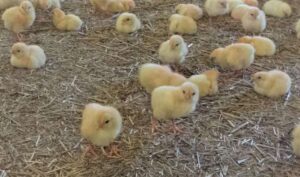
Switchgrass Used as Poultry Bedding
PA Farm Show & Bloomsburg Fair
• Ag Shows & Expos and County Fair Contact Information Records & Follow-Up:
There were dozens of inquiries and follow-up requests from visitors who asked for additional information on switchgrass and other warm season grasses. These inquiries were tabulated and sent to the Chairman of the Association, who ensured that appropriate information was sent to those who visited our exhibits at each of the shows/expos. Those who had grass for sale were referred to Dan Arnett at Ernst Seed LLC for his help in connecting them to buyers. Summaries of our experiences were shared with the Association membership during each of our Annual Summer Meetings held in July of 2018 & 2019.
From the SARE FNE17-865 Final Project Report we learned the following about the delivered poultry bedding:
- Poultry farmers want bedding less than 1.5″ in length.
- Poultry farmers want a bedding with a low moisture content. Warm season grass comes out of the field at 6% – 8% moisture content.
- Poultry Farmers want a bedding with minimal dust content. Because of the low moisture content, warm season grass is very brittle and can produce a large amount of dust.
- The hammermill with a 3/4″ screen processed the material to the desired length. When combined with a cyclone separator and deposited into a 4’x4’x4′ super sack the material was within the desired specifications. This process is the most available combination of equipment.
- The 4’x4’x4′ super sacks were by far the easiest containers to fill. If the “bang-the-bag” technique was used, any remaining dust from the cyclone dropped to the bottom of the bag. In addition, the material in the bag was compacted by the action. The sack weighed about 200 pounds when filled. Supersacks were cumbersome for some to use at the county fairs….too heavy.
- The 16″x 12″x 35″ 30-gallon paper bags were the most desirable containers. They weighed around 30 pounds when filled and were easy to stack on pallets and transport. The biggest drawback was in locating an economical bag source.
- The automated 30-gallon paper bag process farmer Len Reggie developed is a very efficient way to process and bag warm season grass bedding. The disadvantage of the system is it is only available at the Reggie farm. Transporting material from other farms for processing at the Reggie farm is not cost effective. If the Reggie equipment was mounted on a trailer and moved from farm to farm, bedding could be processed at any time of year. Such a unit could possibly service up to 8 farms. This is an area for additional study.
These lessons are important based on our experiences at the Keystone Farm Show and the Pennsylvania Farm Show. At the Keystone Farm Show, people were joining the Association and paying dues on the spot. We handed out all of our business cards at that show and the PASA Winter Conference. We delivered switchgrass in six 200-pound supersacks to the Harrisburg Farm Show the week before it opened. They received more than they needed, not knowing how much they would use. Great feedback from everyone there. The barn manager was pleased with the bedding and would like it again next year.... only not so much and in smaller packaging. Supersacks are a great way to move material, but are cumbersome for some, who would prefer the 30-pound paper bags.
Between the Bloomsburg County Fair and the Pennsylvania Farm Show in Harrisburg, we had warm season grass in 1700 bird cages. The reaction has been positive. Other county fairs shared similar experiences. They liked that the switchgrass bedding stayed in the cages with the metal floors. There was not a lot of dust and the birds didn’t seem to scratch it out of the cage. With some of the flighty birds, it cut down on airborne debris. However, the workers did not like the bulkiness of the supersacks. They were too heavy if they had to move them. Also, they had to wear gloves due to fine stickers and thistle mixed in with the grass.
The Poultry Chairman at the Harrisburg Farm Show reported that everyone was very happy with the performance of the warm season grass as an ammonia controller and as a drying agent. It wicked moisture from the pens, and it kept birds drier and odors to a minimum. Even concerns about white birds being discolored proved unfounded. Very pleased with the overall performance of the product.
Exhibiting at farm shows, ag expos and county fairs is a successful method to spread the word about the many economic and environmental benefits of using warm season grass within the Pennsylvania farm community. Funding is needed to meet the registration requirements at these shows and expos. Some are not as large as others, and so, it is prudent to focus on those venues offering the largest returns. For instance, our next exhibit will be at the Pennsylvania Farm Bureau’s Annual Meeting in November 2019 in Hershey, PA. The outreach potential at that meeting is to exhibit the benefits of warm season grasses to the Bureau’s 48,000 members.
• Grass Producers Directory:
The Pennsylvania Grass Producers Survey Form was sent to known warm season grass producers. New producers are added to the database as we meet them at the various shows and expos. View the Grass Producers Survey Form, Producers Map, and 2019 Pennsylvania Warm Season Grass Producers Directory listed below:
SURVEY FORM – Grass Producers Survey Form
THE DIRECTORY – 2019 Warm Season Grass Producers Directory
PRODUCER’S MAP –
• Ground-Truthing Fields for Acceptability:
Up to 50% of the surveyed grass farms were visited in order to verify that farmers were growing stands of warm season grasses and that they were healthy, merchantable, and tolerably weed-free.
All farms visited to verify/satisfy the ground-truthing requirement were growing excellent switchgrass/warm season grass crops. The following illustrate some of those healthy, marketable fields growing in Pennsylvania:
Bater Farm Stickle Farm
Trumbower Farm International Conservation Center
(Pittsburgh Zoo Elephant Mating Farm)
Penn State University Glennon Farm
Brandau Farm
The Association needed a method or standard to evaluate (ground-truth) how much weed content is acceptable for a field of grass to be merchantable. Dan Arnett, Ernst Conservation Seed LLC, described his method for determining acceptable weed content for fields he evaluates. That method is an acceptable technique the Association members can use when evaluating a field’s weed content or “purity” and is described as follows:
- With both hands, encircle a bundle of cut grass, such that fingers and thumb of the left hand just touch the fingers and thumb of the right hand, respectively. Squeeze together a tightly packed bundle of grass now, such that your fingers and thumbs just barely touch!
- Now open both hands, palms up, allowing the bundle to fall open across your palms for visual inspection.
- Begin searching the grass bundle for evidence of “weeds”, that is, plant stems other than the desired grass crop species.
- Count the weed stems. The bundle is acceptable if the “weeds” number less than 15.
- Sample multiple bundles across the field. If most samples are acceptable, the field of grass is tolerably weed-free and merchantable.
Education/Outreach Description:
Super Sack Demonstrations at County Fairs & Exhibits at Farm Shows and Ag Expos:
The purpose of our campaign to market warm season grasses to the Pennsylvania farm community was to get the Association’s mission and objectives out to the farmer, illustrating to the farm community that incorporating warm season grasses into their farming operations is viable, useful, sustainable. Taking supersacks of switchgrass to 4 county fairs and the PA Farm Show and sharing experiences and knowledge at 4 other farm shows/ag expos did just that. With this approach, the Association anticipated reaching out to thousands of attendees at those fairs, shows, and expos. The goal was that we would educate potentially 5,000 farmers/attendees. The following table illustrates our results:
Farm Shows, Ag Expos, & County Fairs:
|
EVENT |
DATE |
ATTENDEES |
1% REACHED |
|
Ag Progress Days |
August 14-16, 2018 |
42,000 |
420 |
|
Keystone Farm Show |
January 9-11, 2019 |
50,000 |
500 |
|
PASA Winter Conference |
February 6-9, 2019 |
1,800 |
18 |
|
Ag Progress Days |
August 13-15, 2019 |
46,000 |
460 |
|
Lycoming County Fair |
July 10-20, 2018 |
120,000 |
1200 |
|
Montour-DeLong Community Fair |
July 29 – August 3, 2018 |
18,500 |
185 |
|
Northumberland County Fair |
August 21-24, 2018 |
20,000 |
200 |
|
Bloomsburg - Columbia County Fair |
September 21-28, 2018 |
400,000 |
4000 |
|
Pennsylvania Farm Show |
January 5-12, 2019 |
500,000 |
5000 |
|
|
Estimated Totals |
1,198,300 |
11,983 |
If we reached just 1% of the attendees with our message, the Association’s marketing campaign impacted/educated roughly 12 thousand people. Those impacted include those who stopped by our exhibit to ask & discuss questions, picked-up literature, or browsed quietly. They include those who read our banners & signs at the county fairs and saw switchgrass bedding in use by dairy cows, horses, goats, smaller animals and poultry.
We exceeded our goal to educate 5,000 people from the Pennsylvania farm community and increased their awareness about using warm season grasses in their farming operations.
Press Releases & Display Ads:
- The 2018 Press Release: Will Brandau, Chairman, Association of Warm Season Grass Producers, prepared a press release on the work that the Association was doing to promote the marketability of warm season grasses. The press release (attached) went out October 30, 2018 to the following 16 farming publications:
|
Agri News |
Farm Progress |
|
American Farm Bureau |
Farm Industry News |
|
American Farm Bureau Federation |
Farmer Iron |
|
Dairy Business |
Farm World |
|
Lancaster Farming |
American Farm |
|
Successful Farming |
Biomass International Magazine |
|
The Farmer’s Friend |
Citizens Voice |
|
Farming Magazine |
River Reporter |
"A Census Project to Find Warm Season Grasses" - 2018 Article
Not knowing the circulation of all 16 newspapers/magazines and, conservatively, if we educated only 1,000 readers for each publication, then we impacted/educated about 16,000 people in 2018.
- The 2019 Press Release: Late summer of 2019, the Association decided to place advertisements and information articles in two ag-specialty newspapers to promote the Association of Warm Season Grass Producers’ AWSGP objectives and to solicit potential members, grass customers, and producers. The Farmer’s Friend, Towanda, PA and Lancaster Farming, Ephrata, PA were the two newspapers selected.
The Farmer’s Friend is a specialty agriculture newspaper of The Daily Review and has a circulation of 8,000. They cover most of north and central Pennsylvania and the southern tier counties of New York up into the Finger Lakes region. Our ad campaign included a three-week run using the “Where’s the Grass?” display ad (see below) for the Empire Farm Days festival publication (New York), as well as an 8-week run in The Farmer’s Friend, distributed in Pennsylvania.
Lancaster Farming has a circulation of 60,117 and is the leading Northeast and Mid-Atlantic farming and ag industry newspaper. Lancaster Farming covers various agriculture industries. Our ad campaign included a 10-week run for both the “Where’s the Grass?” display ad and the newspaper article “Changing the Focus: Demand for Switchgrass Exceeds Supply” by Will Brandau, Chairman, AWSGP (also below). Also, the display ad was entered in their 2019 Ag Progress Days festival publication.
Conservatively, if we educated only 10% of their readership (read as “circulation”), then we educated/impacted approximately 6,800 people in 2019 during the September-October ad runtime.
Combining this impact with the 2018 ad campaign in 16 newspapers, our two ad campaigns for 2018 and 2019 educated or impacted about (16,000+6,800) 22,800 people. Our initial goal was to reach 5,000 people from the Pennsylvania farm community and help them begin using warm season grasses in their farming operations.
"Changing the Focus: Demand for Switchgrass Exceeds Supply" - 2019 Article
The Farmers Friend Ad Tear Sheet
2” X 3” Display Ad
Grant activities have created exposure for others within the farm community:
Custom Harvester: There is a need for custom harvesters who will harvest grass fields farm-to-farm. N. Moss from Luzerne County is one such harvester. He makes round bales of switchgrass and achieves about 800 pounds /bale. He is also a grass grower and is listed now in the 2019 Directory of PA WS Grass Producers.
Grass Broker: M. Stoltzfus, Reading PA does not grow grass, but sells bedding products. He wants large quantities of switchgrass bales for his brokerage.
Custom Cutting & Management Opportunities: A Bucks County hospital is interested in switchgrass. They own acres of land surrounding their hospital, which they maintain as lawn, using hospital staff. Switchgrass requires less maintenance. It is cut less often than lawn turf; however, the hospital does not want to manage/sell harvested bales.
At the PASA Winter Conference, N. Crooke, Windybush Hay Farms, introduced that his Bucks County farm is not far from the hospital. They manage/harvest 80 acres of switchgrass each year from Pennypack Park, Montgomery County. It is delivered/sold as boiler fuel to the 7-acre floral greenhouse in Harmony, NJ. The greenhouse operator needs more switchgrass square bales to feed his boiler, so W. Hay Farms would be agreeable to manage-sell-store-deliver the grass they would establish on the hospital’s property. If acceptable terms can be reached, this arrangement could be a win-win for all.
Warm Season Grass as Pollinator Habitat: The Fort Indiantown Gap Army Depot, Dauphin County, is the last live-round artillery range on the U.S. east coast. They manage natural switchgrass prairieland to maintain open areas on their depot for military exercises and live-round artillery practice. They also maintain 219 acres of natural prairie grassland as nesting habitat for the repatriation of the regal fritillary butterfly. Loss of these native grasslands at this army depot would result in the extirpation of this butterfly species from Pennsylvania. The regal fritillary butterfly community at the army depot is the last found in Pennsylvania. The only other population of this butterfly in eastern U.S. is found at Radford Army Ammunition Plant in VA. Repatriation efforts are underway at other locations in Pennsylvania, including DCNR state parks, Valley Forge National Historical Park and Gettysburg National Military Park.
Care for this butterfly has become increasingly popular. The Army Depot provides guided tours from May into July. Although they grow and manage a couple hundred switchgrass acres, they don’t sell switchgrass.
photos: Dan Gleiter
Guided Butterfly Tours, Fort Indiantown Gap Army Depot
There are several producers in Pennsylvania that manage their grass fields for wildlife and pollinator habitat. T. Stickle (Westmoreland County) manages a combination of warm and cool season grasses, 200 acres planted in contour strips, to provide a variety of habitat for game birds and wildlife as well as pollinator habitat. Click on a photo and zoom-in for a better view of the distant field!
Stickle’s Cool & Warm Season Grass Contour Strips
B. Trumbower (Luzerne County) also manages his 35 acres of switchgrass, Big Bluestem, and wildflowers for wildlife and pollinator habitat. We had many butterflies and dragonflies join our July field tour.
Trumbower’s Pollinator Habitat
Presentations: Updating the AWSGP Membership, and Other Outreach Activities:
The AWSGP members were updated/informed during three AWSGP Annual Meeting: June 2017, July 2018, and July 2019. At each of these summer meetings, a PowerPoint presentation provided members with recent developments/accomplishments with the NE SARE Grant. Each meeting was accompanied by a field tour of switchgrass plantings. A total of 85 members, farmers, and associations received these educational updates.
Coordinated a field tour for the Mid-Atlantic Biomass Expos MABEX September 2017 conference at Brandau’s farm for his presentation on the many uses for switchgrass and on pelletizing switchgrass. 14 attended.
While conducting the Grass Producers Directory, surveyed farmers interested in switchgrass establishment and production. Encouraged them to join the Association. 5 farmers became new producers and joined the Association.
Attended a PA state prison meeting March 2019 to present the benefits and uses of switchgrass as a boiler fuel and the potential benefits to growing it on prison grounds. 6 staff and researchers attended.
Met with the Pittsburgh Zoo's ICC Staff, Somerset County November 2017 to discuss feasibility of switchgrass as boiler fuel to heat their elephant birthing barn. The ICC is the International Conservation Center also known as the Pittsburgh Zoo Elephant Mating Farm. They grow and use switchgrass as bedding and feed. 5 attended.
Coordinated a tour Feb. 2018 of the greenhouse in Harmony NJ that heats with switchgrass square bales…. on behalf of the ICC, Somerset County and with Biomass Systems Supply representatives. 6 attended.
Made a presentation November 2018 at Smith College, Northampton, Massachusetts to engineers and university facility managers on the Lin-Ka boiler fueled with switchgrass and woodchips, highlighting the greenhouse in Harmony NJ as a successful example. 58 attended.
Made a presentation at the PASA Winter Conference on the economic and environmental benefits of using switchgrass in farming operations. 12 attended.
Through this SARE grant project, the Association of Warm Season Grass Producers conducted a marketing campaign that introduced the Pennsylvania farm community to the many benefits of using warm season grass. We demonstrated to farmers firsthand what warm season grass looks like and how its many product forms out-perform other bedding straw or sawdust products currently used by farmers. The goal was to reach out to at least 5,000 Pennsylvania farmers during the 1½ year project, to help them discover the many economic and environmental benefits of these grasses, and to help them begin using these products in their farming operations.
The Association surveyed current grass producers in Pennsylvania and published a directory and interactive map of these farms. The directory & map provide the producer’s farm location, product type grown, acreage in production, product form (round or square bales), availability, and delivery distance.
The Association took Switchgrass to 4 county fairs/ PA Farm Show and gave it to farmers who were showing their dairy cows, horses, goats, small animals, and poultry to fair visitors. Their response to using this alternative bedding was positive and encouraging.
We also exhibited and shared product use information at 4 ag shows and expos, introducing warm season grass as bedding, as an erosion & sedimentation control silt sock, as a boiler fuel, and as a conservation measure for restoring animal and pollinator habitat.
Our efforts at the county fairs, farm shows and ag expos educated/ impacted approximately 12,000 farmers and show attendees.
The Association’s efforts also included a press release and advertisement marketing campaign for a couple months during 2018 & 2019, reaching over 1½ dozen newspapers and magazines, and educating approximately 22,800 farmers/readers.
Overall, we estimate that by reaching and educating 12,000 farmers and others attending our fair demonstrations and show exhibits, we had exceeded our initial goal to educate 5,000 farmers and attendees from PA's farm community.
There were farmers exhibiting at the county fairs and farm shows who have called us back to demonstrate our bedding during next year’s fairs and shows. Some farmers placed orders, found new markets for their current Switchgrass crop, or have committed to growing warm-season grass on their farm acreage. As a result of attending and exhibiting at farm shows and fairs during this project, the Association gained 50 new members and 20 new grass producers.
The price of Switchgrass has climbed from $65 to $90 to $150-165 per ton during the length of this grant project. The Association’s website www.awsgp.org visitation log has climbed from a few hundred per month to over 600 visits per month during this project
Quality of grass product has been steadily improving. When silt sock companies started buying Switchgrass, farmers with old grass fields… mixed with thistle, golden-rod and briars… delivered poor-quality baled grass. Silt sock producers asked the Association for help getting the word out that bales must come from cleaner stands of Switchgrass to be of any service to this new industry. The Association had many opportunities helping producers improve their Switchgrass fields and delivered products.
The farm shows, county fairs, and ag expos are terrific venues to visit with farmers and build relationships over several years. Registration fees at some of these are expensive. For example, the PASA Winter Conference is fun and the topics are valuable. Registration is hundreds of dollars, and only around 1,800 visitors attend. In contrast, the Bloomsburg Fair and the PA Farm Show have 400,000 and 500,000 in attendance and the price to get in is the cost of parking. They are equally fun and attendees are interested in our information. So, we need to be smart about our event choices and spend our resources at those shows with the greatest attendance.
Also, we need to learn how to test the effectiveness of our marketing and media campaigns to quantify outcomes. That will conserve human resources as well as money.
Education & outreach activities and participation summary
Participation summary:
All Education & Outreach Activities are listed in the Research Section above.
12,000 farm show / ag-expo / fair participants & farmers educated & impacted.
22,800 media / newspaper press release / festival program readers & farmers educated & impacted.
Learning Outcomes
Over 205 livestock raisers reported changes in knowledge, attitude, skills, and awareness as a result of this project. The following key areas describe the many activities contributing to these reported changes. If 10% were commercial farmers, then we estimate 20 farmers learned about Switchgrass as a potential bedding option.
During the 2018 Lycoming County Fair, 65 exhibitors used switchgrass as bedding while showing poultry, rabbits-cavies, and goats. At the 2018 Bloomsburg County Fair, 31 people exhibited poultry in 900+ cages lined with Switchgrass bedding. The Bloomsburg County Fair exhibitors initially responded favorably to using the grass as bedding; however, during their fair week they changed their poultry feed. There was also extra surface water (flooding) due to rain events that week. Subsequently, the chickens produced more droppings or diarrhea from their change in diet. Coupled with the surface rainwater, there was a noticeable increase in barn odors. Using grass as bedding was blamed for this increase in odors, so the fair is not asking for Switchgrass next year and is going back to using sawdust and their former poultry feed brand to correct the odor problem.
During the 2019 Pennsylvania Farm Show there were 311 farmers showing horses, dairy cows, and poultry. Out of that total, we delivered supersacks of Switchgrass bedding to the 104 poultry raisers exhibiting their 712 caged poultry entries.
Also, Switchgrass bedding was delivered in supersacks and 30-pound papers sacks to the 2018 Montour-Delong Community Fair and the 2018 Northumberland County Fair. Initially, we received positive feedback from livestock managers using the bedding; however, these two fairs did not respond to our requests for numbers of exhibitors who used the switchgrass for their show animals. Therefore, there are no firm numbers on farmers reporting changes, education or other impacts.
In total at least (65+31+104=) 200 livestock raisers plus 5 livestock barn managers at the county fairs and the PA Farm Show were impacted or educated by this switchgrass as animal bedding demonstration.
In summary, the Association is the primary group to assist the farm community how to successfully market warm season grasses, especially switch grass. Dairy, poultry, horse farms and those raising smaller animals learned that switchgrass is an acceptable and useful material for bedding. Industrial and institutional users learned that this grass can be used to fuel boilers; thereby avoiding the higher costs of other heating fuels. They learned that some of these end users may grow their own fuel sustainably on their own acres. The grass silt sock producers demand relatively weed-free stands of switchgrass. Farmers interested in selling existing fields of grass or those looking to plant new stands and enter this market received help/education on how to provide clean, weed-free, properly constructed grass bales, either square or round. Environmentalists learned that fields of switchgrass have a positive impact as habitat for wildlife and pollinators. Pollinators need native plants for nesting and habitation. A variety of insects struggle in environments cultivated with introduced plant species. Planting switchgrass is a means to re-establish natural habitat to aid in the repatriation of butterflies and other pollinators.
Most livestock barn managers at the County Fairs and PA Farm Show requested more switchgrass next year, especially the more manageable 30-gallon sacks. Much of the feedback from participants at the fairs and shows has been positive. Most outstanding comments include… ease of use, better clumping features, more absorbent, reduced ammonia odors, dries out quickly, sheds easily from animal’s fur, cleaner animals, animals stay cleaner long, cost effective, decomposes quickly in the field, less tannic acid.
Participants at the other Farm Shows, Conferences, Ag Expos were positive and expressed their increased awareness of warm season grasses and how to use them in their own farming operations. Feedback requests were for organic switchgrass products. Some have agreed to establish and grow warm season grasses, join the Association, and participate in the 2019 Pennsylvania Warm Season Grass Producers Directory.
Association member farmers are learning to better manage their fields. Techniques and equipment trials are shared regularly. Producers participate and report their experiences during our Annual Meetings. New project reports are timely. Old project ideas have been filed away all the better for the experience. For example, some tried to pelletize their own grass fuel pellets. With much finesse a good product can be made, but most agree that farmers have too much other good work to do than to spend so much time fussing with an on-farm pellet mill. Best to learn how to burn the whole grass bale without densification (i.e., Lin-Ka Energy Boilers).
Project Outcomes
As a result of this marketing campaign, 24 warm season grass producers/farmers completed the inventory survey for the Association's grass census database. Thirteen of these 24 farmers were new to grass production. The grass census database was used to create the new 2019 Pennsylvania Warm Season Grass Producers Directory. The 24 Pennsylvania farmers that completed the inventory survey grew a total of 4,743 acres of warm season grasses in 2019. That is an equivalent annual production of approximately 14,000 to 19,000 tons of warm season grasses for 2019. Of the 4,743 acres of grass reported in the 2019 PA database, approximately 544 are new acres reported during our year and a half project period. All farmers have received information on improving their grass crops/ fields because of the demand for cleaner bales, fewer weeds in their round or square bales. Grass product is improving throughout the Association membership as the result of this awareness.
The Association of Warm Season Grass Producers reports 50 new members joined the Association, 20 of which became new producers and started growing warm season grasses as a result of this marketing campaign. Another farmer from Bedford County plans to increase his farm's grass production by another 20 acres next spring. In Westmoreland County, a farmer manages his fields for wildlife and pollinator habitat using both warm and cool season grasses planted in contour strips. He joined during my farm visit.
Four of the County Fair/Farm Show livestock managers are interested in using Switchgrass as animal bedding. If we continue exhibiting at future fairs and shows, that will continue to impact, educate, encourage farmers to adopt these new practices for their farming operations.
During our year and a half project period, the value of a bale of Switchgrass has gone from $65 to $90 to $150-$165 per ton. This increase has been a game-changer for the farmer producing grass in Pennsylvania.
At the beginning of our grant project, our Association's website www.awsgp.org received 300 visits per month. Currently, our website visitation log has doubled to 600 visits per month.
So, because of this project we know that (24+50) 74 farmers changed or adopted a practice and 4 of the County Fair or Farm Show livestock managers want to use Switchgrass for animal bedding. Exhibiting at farm shows, ag expos and county fairs is a successful method to spread the word about the many economic and environmental benefits of using warm season grasses within the Pennsylvania farm community.
- This study has focused the farm community’s as well as the memberships’ attention on Switchgrass markets. It opened pathways to two large manufacturers of environmental silt sock who were looking for grass instead of woodchips to stuff into their fabric tubes. The resultant change in value for a bale of Switchgrass has been a game changer for farmers. Prices went from $65 to $90 to $150-165 per ton of switchgrass during our year and a half project period. Quality of grass product has been steadily improving.
- The Association’s participation at county fairs, farm shows and ag expos has been a terrific way to spread our message, mission, and education to many in the farm community. This participation is expensive, but with our growing membership we will continue to participate even if on a limited scale. The Association plans to exhibit at the Pennsylvania Farm Bureau’s Annual Meeting this November 2019. The potential is there to reach 48,000 members in that organization.
- We need to learn how best to use media display ads and newspaper articles. There are ways to test reader response rate and how effective our message was to change behaviors or cause a reaction. Testing following a display ad or published article will give us hard numbers rather than relying on a “shotgun” approach for desired results.
- Going forward, we need to expand our outreach if we are to continue marketing warm season grasses within the farm community. The Association cannot do this alone, but how better to bring other influencers into our campaigns and into our Association. There are dozens of Pennsylvania colleges and universities with sustainable agriculture and environmental sciences curricula. We need to build relationships with them to broaden our outreach and expand our mission. Association member R. Evangelista has begun a plan to reach out to colleges that support curricula in sustainable agriculture and environmental sciences. By introducing ourselves to these institutions, we may likely discover we have mutual goals. Working together, we will accomplish objectives more quickly and to a larger audience. A partial list of some Pennsylvania colleges and universities with sustainability curricula follows:
|
Sustainable Agriculture and Environmental Sciences Curricula
|
|
|
Delaware Valley University |
Susquehanna University |
|
Carnegie Mellon University |
Wilson College |
|
Lehigh University |
Keystone College |
|
University of Pittsburgh |
Juniata College |
|
Temple University |
Westmoreland Comm. College |
|
Drexel University |
Luzerne County Comm. College |
|
Saint Francis University |
Slippery Rock University |
|
Albright College |
Saint Vincent College |
|
Chatham University |
Dickinson College |
|
Mercyhurst University |
Allegheny College |
- The Association needs to research Switchgrass as an alternative to more expensive, genetically modified straw products (wheat-oats-barley). Genetically modified straw products are designed to produce larger seed heads for obvious reasons, but intentionally or otherwise, they also produce smaller straw bodies. Having smaller straw bodies is problematic. It has led to straw scarcity and that has driven-up prices. Abundant supplies of Switchgrass would satisfy demand, but more understanding is needed to compare prices, markets, and the true extent of the issue. A market analysis is needed.
- Grassland acres coming out of the Conservation Reserve Program CRP present an enormous opportunity to the Association and related industries in need of switchgrass.
- From the NRCS brochure, “the Conservation Reserve Program is a federal program that gives landowners an annual per-acre payment to take environmentally sensitive farmland out of production. The land receives a specially designed vegetative cover that reduces soil erosion, improves soil and air quality and develops wildlife habitat. CRP contracts typically are for 10 or 15 years, after which, the land may be returned to traditional crops.”
- Some elect to take their acreage out of CRP early for several reasons. These include:
- funding isn’t available to keep it in the program.
- farming practices, especially on environmentally sensitive land, have improved.
- crop prices and farm profitability may be strong.
- The Association needs to better understand the CRP and how it works; how many Pennsylvania farms are enrolled in the CRP; and how many farms come out of CRP each year. The CRP was designed to protect marginal, erodible acres. Government agencies that promote CRP want to protect sensitive areas as long as possible. However, technology and machinery have changed in the decades since these acres were put in the program. Switchgrass does well on marginal lands and advancements in no-till planting techniques make Switchgrass a viable choice for grassland management on sensitive acreage.
- The Association needs to develop better relationships with the Farm Services Agency FSA and Natural Resource Conservation Service NRCS. They are reluctant to share farmers’ names and addresses, so contacting farmers to learn when their contracts expire and what they intend to do with their acreage once out of CRP is a challenge. Agencies want their farmers to keep environmentally sensitive acres in cover and protected from erosion. The Association does not want these lands damaged either; nonetheless, we need to encourage the NRCS and FSA and others that with improved farming practices and current technologies, managing these sensitive acres in switchgrass can be sustainable for the resource and profitable for the farmer.
